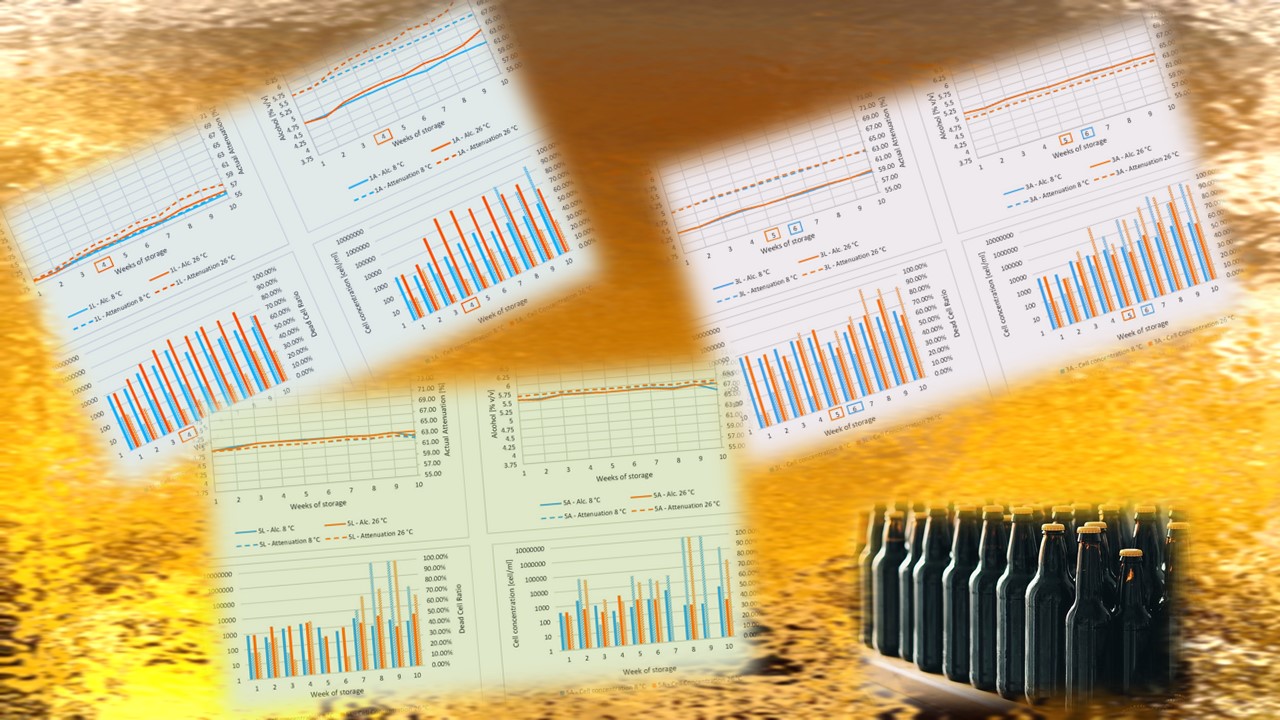Alert for microbreweries – a case study on unpasteurized and unfiltered beer
Keywords:
storage temperature, yeast autolysis, beer stabilityAbstract
Beer stability, influenced by physical, chemical, and biological factors, poses a considerable challenge for breweries. Biological stability, a major concern, is effectively managed through practices such as good hygiene, pasteurization, and filtration. Microbiological contamination, often recognizable by increased turbidity or off-flavours, is influenced by temperature, with optimal vital conditions promoting the growth of specific microorganisms. Lower temperatures slow down flavour changes and chemical reactions in beer, impacting non-biological stability. This case study explored the impact of storage temperature on autolysis off-flavour development in 10 different unfiltered and unpasteurized beers. The results showed that autolysis off-flavour occurred at both low and higher storage temperatures and that the temperature dependence was minimal. This unexpected fact was mainly due to the uncovering of significant contamination of the commercial beers tested (wild yeasts, lactic acid bacteria, enterococci and coliform bacteria). For this reason, the concentration of cells in the beer appeared as a more influential factor in the development off-flavours, including autolysis, that the storage temperature. The partial results need to be studied in more detail nevertheless we felt it was important to publish the revelation of a strong contamination of beers purchased for experiments from regular stores. It can already be concluded at this point that the low storage temperature did not help to prevent the development of the contamination and the associated sensory deterioration of the beers.
References
Aguiar, D., Pereira, A. C., & Marques, J. C. (2022). The Influence of Transport and Storage Conditions on Beer Stability—a Systematic Review. Food and Bioprocess Technology, 15(7), 1477-1494. https://doi.org/10.1007/s11947-022-02790-8
Alexandre, H., & Guilloux-Benatier, M. (2006). Yeast autolysis in sparkling wine – a review. Australian Journal of Grape and Wine Research, 12(2), 119-127. https://doi.org/https://doi.org/10.1111/j.1755-0238.2006.tb00051.x
Axelsson, L. (2004). Lactic Acid Bacteria: Classification and Physiology. In (pp. 1-66).
Baert, J. J., De Clippeleer, J., Hughes, P. S., De Cooman, L., & Aerts, G. (2012). On the Origin of Free and Bound Staling Aldehydes in Beer. Journal of agricultural and food chemistry, 60(46), 11449-11472. https://doi.org/10.1021/jf303670z
Bamforth, C. W. (1999). Beer haze. Journal of the American Society of Brewing Chemists, 57(3), 81-90.
Boulton, C., & Quain, D. (2001). Brewing Yeast and Fermentation. Blackwell Science Ltd.
Jaskula-Goiris, B., De Causmaecker, B., De Rouck, G., Aerts, G., Paternoster, A., Braet, J., & De Cooman, L. (2019). Influence of transport and storage conditions on beer quality and flavour stability. Journal of the Institute of Brewing, 125(1), 60-68. https://doi.org/https://doi.org/10.1002/jib.535
Juvonen, R., Virkajärvi, V., Priha, O., & Laitila, A. (2011). Microbiological spoilage and safety risks in non-beer beverages. VTT Tiedotteita-Research Notes, 2599, 107.
Kaneda, H., Kobayashi, N., Furusho, S., Sahara, H., & Koshino, S. (1995). Chemical evaluation of beer flavor stability. Technical Quarterly-Master Brewers Association of the Americas, 32(2), 76-80.
Kubizniaková, P., Brožová, M., Štulíková, K., Vontrobová, E., Hanzalíková, K., & Matoulková, D. (2020). Microbiology of brewing production - bacteria of the order Enterobacterales and culture methods for their detection. KVASNY PRUMYSL, 66(5), 345-350. https://doi.org/10.18832/kp2019.66.345
Kulka, D. D. (1953). Yeast Autolysis and the Biological Stability of Beer. Journal of the Institute of Brewing, 59(4), 285-293. https://doi.org/https://doi.org/10.1002/j.2050-0416.1953.tb02718.x
Liu, C., Shen, Y., Yin, X., Peng, L., & Li, Q. (2014). Influence of Pasteurization and Microfiltration on Beer Aging and Anti-Aging Levels. Journal of the American Society of Brewing Chemists, 72(4), 285-295. https://doi.org/10.1094/ASBCJ-2014-0925-01
Matoulkova, D., Kopecka, J., & Kubizniakova, P. (2013). Brewing microbiology - wild yeasts and methods of their detection. KVASNY PRUMYSL, 59(9), 246-257. https://kvasnyprumysl.cz/en/artkey/kpr-201309-0003.php
http://dx.doi.org/10.18832/kp2013025
Matoulková, D., & Kubizniaková, P. (2015). Lactic acid bacteria and cultivation methods of their detection - Part I [journal article]. KVASNY PRUMYSL, 61(3), 76-88. https://kvasnyprumysl.cz/en/artkey/kpr-201503-0003.php
http://dx.doi.org/10.18832/kp2015012
Paternoster, A., Jaskula-Goiris, B., Buyse, J., Perkisas, T., Springael, J., Braet, J., De Rouck, G., & De Cooman, L. (2020). The relationship between flavour instability, preference and drinkability of fresh and aged beer. Journal of the Institute of Brewing, 126(1), 59-66. https://doi.org/https://doi.org/10.1002/jib.582
Stewart, G. G. (2004). The Chemistry of Beer Instability. Journal of Chemical Education, 81(7), 963. https://doi.org/10.1021/ed081p963
Stewart, G. G. (2016). 10 - Beer Shelf Life and Stability. In P. Subramaniam (Ed.), The Stability and Shelf Life of Food (Second Edition) (pp. 293-309). Woodhead Publishing. https://doi.org/https://doi.org/10.1016/B978-0-08-100435-7.00010-1
Suzuki, K. (2015). Gram-positive spoilage bacteria in brewing. In (pp. 141-173). https://doi.org/10.1016/B978-1-78242-331-7.00007-1
Vaughan, A., O'Sullivan, T., & Van Sinderen, D. (2005). Enhancing the Microbiological Stability of Malt and Beer — A Review. Journal of the Institute of Brewing, 111(4), 355-371. https://doi.org/https://doi.org/10.1002/j.2050-0416.2005.tb00221.x
Vosti, D. C., & Joslyn, M. A. (1954). Autolysis of baker's yeast. Appl Microbiol, 2(2), 70-78. https://doi.org/10.1128/am.2.2.70-78.1954
Wang, J.-j., Xu, W.-n., Li, X. e., Li, J., & Li, Q. (2014). Absence of fks1p in lager brewing yeast results in aberrant cell wall composition and improved beer flavor stability. World Journal of Microbiology and Biotechnology, 30(6), 1901-1908. https://doi.org/10.1007/s11274-014-1617-0
Xu, W., Wang, J., & Li, Q. (2014). Microarray studies on lager brewer's yeasts reveal cell status in the process of autolysis. FEMS Yeast Res, 14(5), 714-728. https://doi.org/10.1111/1567-1364.12156

Published
How to Cite
Issue
Section
License
Copyright (c) 2024 Karel Fous, Anna Jarolímková, Petra Kubizniaková, Katarína Majtán

This work is licensed under a Creative Commons Attribution 4.0 International License.







